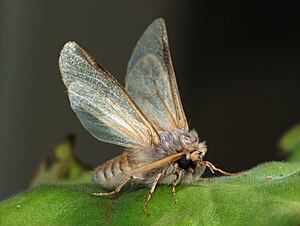Wikipedia:Featured picture candidates/Image:Moth September 2008-3.jpg
📷
Pine Processionary Moth


- Reason
- a detailed and high quality depiction of a Pine Processionary Moth, a common forest pest, adding value to the articles
- Articles this image appears in
- Thaumetopoeidae
- Creator
- Joaquim Alves Gaspar
- Support as nominator --Alvesgaspar (talk) 23:02, 9 September 2008 (UTC)
- Oppose - Too much of the subject is out of focus. (Giligone (talk) 01:06, 10 September 2008 (UTC))
- Comment Motion blur in the wing? Papa Lima Whiskey (talk) 09:33, 10 September 2008 (UTC)
- No, it is just out of focus. This is a really close-up shot and the DOF is shallow (a few mm) despite the very small aperture (F/29). A better focus was achieved in this other version, but the angle is not as interesting. No miracles in macrophotography... -- Alvesgaspar (talk) 09:41, 10 September 2008 (UTC)
- Support original. It's a really good bug pic, and the quality on the rest of the pic and the EV make up for some small diffraction. Intothewoods29 (talk) 00:49, 11 September 2008 (UTC)
- Weak support. The body and wing is off focus.
unsigned entry byZooFari02:52 13 September (UTC) - Question How confident are you of the ID of this image? I ask because the filename "Moth September 2008-3" suggests an ad hoc ID? I did a quick search in google and your image doesn't seem to match: [1] [2] [3]. The wings in this moth appear to be semi transparent? --Abdominator (talk) 04:28, 19 September 2008 (UTC)
- Answer - I'm quite confident about the ID. The wing venation, as well as the dark mark on the underside of the forewing and the frontal protuberence are quite distinctive. Yes, I was also puzzled by the transparent wings held upright. This is explained by the fact that the moth was rescued from the water, where most scales were lost. The wings held upright is probably to help them dry. They also do that when they expand and dry their wings after emerging from the cocoon. -- Alvesgaspar (talk) 07:31, 19 September 2008 (UTC)
OpposeWeak oppose Now that I've learnt that the creature has lost most of its scales, I'll have to oppose. Thanks for your honesty about this fact, but we really can't promote images that are unrepresentative. Eventually, someone will write an article about how moths behave after being immersed in water, but until then... it's a regretful oppose from me. Papa Lima Whiskey (talk) 15:40, 19 September 2008 (UTC) I read the "comment and info" but I'm now thinking that if the wing venation is the feature I should pay attention to, then the blur in the wing (even if not caused by motion) is rather letting us down. Papa Lima Whiskey (talk) 23:01, 19 September 2008 (UTC)- Comment and Info -- Let me defend my knight (the moth is a male...). Rather than harming the EV of the picture I believe that the fact the wings are almost transparent and stretched upwards improves on it. Only this way it is possible to depict some characteristic features of the family (the wing venation and the stout body) and of the species (the white hindwing, the dark mark on the underside of the forewing and the frontal protuberance). Also, this particular view clearly shows a distinctive feature of most moths, the frenulum, which is a bristle springing from the underside of the hindwing and running forward to be held in a small catch (also visible) on the underside of the forewing, the function of the mechanism being to held the wings together when in flight. Of course, all these features can only be shown in a side view, with the wings of the moth held upright, like in th epicture. I know of no other photograph of a living moth showing all this. The captions in the articles will be improved to draw the attention of the reader to the important details. -- Alvesgaspar (talk) 19:10, 19 September 2008 (UTC)
- Almost forgot: this rescue story didn't have a happy ending. Less than one hour after being taken out of the water, and when the moth already seemed ready to fly, it was attacked by a paper wasp and killed (here) !. This must be a rare event as moths are active by night and wasps by day. -- Alvesgaspar (talk) 19:22, 19 September 2008 (UTC)
Not promoted MER-C 07:30, 21 September 2008 (UTC)
